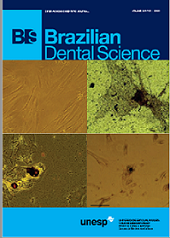Isolation and Characterization of Stem Cells Derived by Human Dental Pulp from Harvest Based in Rotary and Manual Techniques used in Endodontic Therapy
DOI:
https://doi.org/10.14295/bds.2020.v23i1.1753Resumo
Objective: The aim of this study was to evaluate the impact on the isolation and characterization of stem cells from pulp tissues obtained through rotary instrumentation techniques compared to the manual technique. Material and Methods: Thirty permanent teeth were included, 15 of which were instrumented with rotational technique (Protaper SX) and other 15 with manual technique. Cells obtained were characterized by flow cytometry and proliferation was evaluated by the MTT assay. The plasticity was evaluated for adipogenic, osteogenic and odontogenic differentiations. Results: Cells isolated from the pulp of permanent teeth, by manual techniques, presented fibroblast morphology and were able to differentiate successfully. All lineages expressed CD29, CD73, CD90, CD105, CD146, CD166 and were negative for CD31, CD34 and CD45. MTT assay showing significantly increased proliferation of hDPSCs in 5 and 7 days of the culture. Conclusion: The present study demonstrated that manual instrumentation technique is one of the best candidates to harvest dental pulp tissue as the dental stem cell source due to ability effective expanded with less tissue invasion. The technique of rotational instrumentation proved to be very harmful to the tissues of the dental pulp, and we can’t obtain cells using this technique.
Keywords: Root Canal Therapy; Pulpectomy; Anatomy and Histology; Stem Cell.
Downloads
Downloads
Arquivos adicionais
Publicado
Como Citar
Edição
Seção
Licença
TRANSFERÊNCIA DE DIREITOS AUTORAIS E DECLARAÇÃO DE RESPONSABILIDADE
Toda a propriedade de direitos autorais do artigo "____________________________________________________________________" é transferido do autor(es) para a CIÊNCIA ODONTOLÓGICA BRASILEIRA, no caso do trabalho ser publicado. O artigo não foi publicado em outro lugar e não foi submetido simultaneamente para publicação em outra revista.
Vimos por meio deste, atestar que trabalho é original e não apresenta dados manipulados, fraude ou plágio. Fizemos contribuição científica significativa para o estudo e estamos cientes dos dados apresentados e de acordo com a versão final do artigo. Assumimos total responsabilidade pelos aspectos éticos do estudo.
Este texto deve ser impresso e assinado por todos os autores. A versão digitalizada deverá ser apresentada como arquivo suplementar durante o processo de submissão.




























